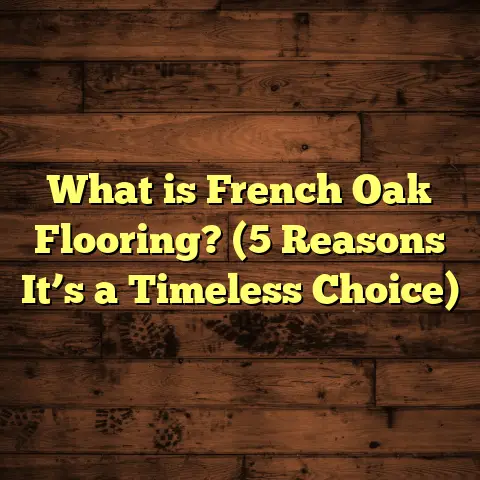What is Black and White Flooring? (5 Styles You ll Love)
Have you ever walked into a space and been instantly captivated by the sharp contrast of black and white flooring? It’s as if the floor itself holds a personality—bold, timeless, and confident. I’ve been in the flooring business for years, and black and white floors never fail to catch my eye. There’s something about this simple yet dramatic color pairing that manages to fit in everywhere, from vintage kitchens to ultra-modern lofts.
It’s a design choice that stands the test of time. But what exactly is black and white flooring? How does it work? And why do so many people keep choosing it, decade after decade? Let me share everything I know about this fascinating flooring style—including some tips, stories, and tools that have helped me get projects just right.
What is Black and White Flooring?
At its core, black and white flooring is any floor treatment or design that prominently features these two colors. But it’s more than just slapping down alternating tiles or painting stripes. It’s a way of playing with light, space, texture, and pattern.
The contrast between black and white creates a visual tension that can either calm a room or energize it—depending on how it’s used. You’ll find black and white flooring in many formats: ceramic or porcelain tiles, vinyl planks, wood painted floors, natural marble slabs, terrazzo mixes, even mosaics made from tiny glass pieces.
Each material brings its own character to the black-and-white theme. For example:
- Ceramic and Porcelain Tiles: These are popular because they’re easy to clean and come in many finishes—from glossy to matte. Porcelain tiles are fired at higher temperatures (around 1200-1400°C), making them denser and more durable than regular ceramic. This firing process also reduces their water absorption rate to less than 0.5%, which makes them great for moisture-prone areas like bathrooms.
- Vinyl Flooring: Often printed with black and white patterns, vinyl is budget-friendly and versatile. Its wear layer protects the printed pattern underneath from scratches.
- Marble: Natural stone offers unmatched elegance with unique black veining on white marble or vice versa. Marble slabs require quarrying, cutting, polishing, and sealing—each step demanding expert craftsmanship.
- Terrazzo: A composite material made by embedding chips of marble, quartz, or glass in cement or resin. The black and white chips create speckled patterns that are both durable and aesthetic.
- Mosaics: Tiny tiles arranged into intricate patterns give a vintage or artistic feel. Glass mosaics add shimmer while ceramic mosaics offer durability.
Manufacturing Insights
Making black and white tiles involves some fascinating processes:
- Porcelain Tile Production: After mixing fine clay with minerals, the mixture is pressed into molds then fired at high temperatures. The firing vitrifies the tile surface, making it hard and impervious to water. For black tiles, manufacturers often add pigments like iron oxide or manganese dioxide before firing. White tiles typically use kaolin clay for their lighter tone.
- Vinyl Printing: Patterns are applied using advanced printing technology onto a vinyl base sheet. A protective wear layer is laminated over the print to prevent fading or scratches.
- Marble Processing: After quarrying large blocks, slabs are cut with diamond wire saws then polished with progressively finer abrasives. Black marble like Nero Marquina comes from Spain; white marble like Carrara from Italy.
- Terrazzo Fabrication: Chips are mixed into a binder (cementitious or epoxy), poured or precast into slabs, cured, then ground and polished to smoothness.
Why I’m Drawn to Black and White Floors
I’ve worked on dozens of projects featuring black and white floors. One client’s kitchen renovation still sticks in my mind: she wanted a vintage vibe but with a fresh twist. We opted for classic checkerboard porcelain tiles but paired them with sleek matte black cabinetry and brushed steel appliances. It was the perfect balance of old-school charm and modern edge.
Black and white floors create interesting optical illusions too. For instance, darker colors tend to recede visually while lighter colors advance. This means you can actually manipulate how big or small a room feels based on the pattern arrangement.
For example, long stripes of black and white planks can make narrow hallways feel longer. Checkerboards can add energy to otherwise plain spaces without overwhelming them if sized correctly.
5 Styles of Black and White Flooring You’ll Love
1. Classic Checkerboard Tiles
Checkerboard floors are probably the most recognizable form of black and white flooring. The alternating square pattern has roots dating back centuries in European castles and Victorian homes.
Materials: Ceramic, porcelain, vinyl
Advantages: Timeless appeal; simple to install evenly sized tiles; fits traditional or contemporary styles
Challenges: In small rooms, it can look busy if the squares are too small or colors too stark
When installing checkerboard porcelain tiles once, I noticed how important it was to plan the layout before setting tiles. Starting from the center of the room helps maintain symmetry. Cutting edge tiles precisely ensures clean lines—no one wants jagged checkerboards!
2. Striped Patterns
Stripes add dynamic movement to flooring. Whether wide or narrow, horizontal or vertical stripes influence perception dramatically.
Materials: Vinyl planks, painted hardwood
Advantages: Can elongate rooms; modern aesthetic; easy to customize stripe width
Challenges: Stripes require precision during installation; misaligned lines can ruin the effect
In a narrow hallway project I did, we installed vinyl strips running lengthwise in black and white. It visually stretched the corridor making it feel more spacious without adding physical space.
3. Geometric Shapes
Using shapes other than squares—like hexagons, diamonds, or triangles—gives floors an artistic flair.
Materials: Ceramic tile, terrazzo
Advantages: Highly customizable; artistic; creates texture through pattern
Challenges: Complex layouts require professional installers; cutting irregular shapes adds labor time
One project featured hexagonal terrazzo tiles with recycled glass chips in black and white hues. The floor was stunning under different lighting conditions—sometimes almost sparkling.
4. Marble Veining
Natural marble floors with black veins on white bases (or vice versa) exude luxury.
Materials: Natural marble slabs
Advantages: Unique patterns; high-end look; adds value to property
Challenges: Costly; requires regular maintenance including sealing
I once sourced Nero Marquina marble for a client’s foyer. Each slab’s veining was different—like art pieces placed on the floor. It created an elegant entrance that guests still talk about years later.
5. Mosaic Patterns
Mosaic floors use tiny pieces of tile to create detailed patterns—perfect for bathrooms or accent areas.
Materials: Glass tiles, ceramic mosaic sheets
Advantages: Custom design options; vintage or artistic look; great for small areas
Challenges: Labor intensive installation; grout maintenance
A bathroom renovation I handled incorporated penny tile mosaics in black and white. It took multiple days to complete but gave the floor tactile interest as well as a splash of personality.
Black and White Flooring Trends & Data
The lasting popularity of black and white floors isn’t just personal preference—it’s backed by industry data:
- A 2023 survey by Home Design Trends USA found 34% of homeowners opt for black-and-white themes in kitchens.
- Bathrooms followed close behind at 27%.
- Real estate agents report properties with stylish black-and-white floors sell on average 5-7% faster than comparable homes without.
- Manufacturers report rising demand for porcelain tiles with classic checkerboard patterns—up 15% year-over-year since 2020.
These stats show buyers appreciate not only aesthetics but also perceived cleanliness and style longevity offered by these floors.
Installation Insights: What Makes Black & White Floors Tick?
Installation quality can make or break black and white flooring impact.
Here are some things I’ve learned over the years:
Surface Preparation
Before laying any tile or plank, the subfloor must be perfectly level and clean. Even minor bumps cause visible unevenness that ruins the precise look black-and-white patterns demand.
Layout Planning
Taking time to map out the pattern on paper or using software helps avoid awkward cuts near walls or doorways. For checkerboards especially—starting from room center keeps symmetry balanced.
Cutting & Handling Tiles
Porcelain tiles require diamond blade cutters for clean edges without cracking. For complex geometric shapes like hexagons, custom jigs make cutting more accurate.
Grouting Choices
For tiles, grout color affects final look hugely. White grout brightens but shows dirt easily; dark gray hides stains better but softens contrast slightly.
Sealing & Finishing
In materials like marble or terrazzo sealing protects from staining liquid spills common in kitchens or bathrooms.
My Go-To Cost Estimation Approach: Using FloorTally
Estimating costs accurately is always tricky due to variable material prices, labor rates by region, waste factors during installation, and complexity of patterns.
That’s why I rely heavily on FloorTally—it helps me run quick but detailed cost calculations tailored to local market conditions.
For example:
- Inputting room dimensions
- Selecting material type (porcelain tile)
- Adding labor cost per square foot
- Including waste factor (usually 10%-15% for tile cuts)
- Factoring in installation difficulty (complex patterns cost more)
FloorTally quickly shows total estimated cost—allowing me to discuss realistic budgets with clients upfront rather than surprise them later.
This saves hours compared to gathering individual quotes then manually calculating totals.
Caring for Black & White Floors: Tips I’ve Learned
Maintaining contrast requires regular care because dirt stands out on both colors:
- Sweep/vacuum daily to prevent grit scratching surfaces.
- Use pH-neutral cleaners designed for specific materials.
- Avoid harsh chemicals that dull finish (especially on marble).
- Seal marble floors yearly.
- Promptly wipe up spills.
- For vinyl floors, avoid abrasive tools that scratch protective layers.
In one home I worked on with black-and-white marble floors, neglecting sealing led to slight discoloration stains after months—but resealing reversed damage quickly once routine set in.
Case Study: Transforming a Family Kitchen
A family in my town wanted their outdated kitchen revamped with something bold yet timeless. We chose porcelain checkerboard tiles paired with matte cabinetry colors inspired by Scandinavian design trends—white upper cabinets and charcoal lower ones.
The installation took four days due to precise layout planning required around island placement. By using FloorTally upfront for budgeting, we avoided surprises caused by additional tile cuts along irregular walls.
The family loved how the floor gave their kitchen personality without overpowering other elements like countertops or appliances.
Other Creative Uses of Black & White Flooring
Black & white flooring isn’t just for kitchens or bathrooms:
- Entryways: Sets an elegant tone right at arrival.
- Living Rooms: Adds drama especially when paired with neutral furniture.
- Commercial Spaces: Restaurants or boutiques use checkerboard patterns for nostalgic vibes.
- Outdoor Patios: Durable porcelain tiles in monochrome patterns create stylish outdoor spaces.
I recently worked on a boutique hotel lobby featuring large-format black-and-white marble slabs with subtle veining—combining durability with style that wowed visitors immediately.
Final Thoughts
Black and white flooring is much more than a decorative choice—it’s a design tool that shapes how we experience space. It can make rooms feel larger or cozier, modern or historic, simple or intricate—all depending on materials used, pattern chosen, and installation quality.
Having worked extensively with these floors across styles—from rustic mosaics to sleek striped vinyl—I’ve seen firsthand how this duo stands out without screaming for attention. It quietly commands respect while allowing other design elements to shine too.
If you’re thinking about adding black-and-white flooring to your home or project, consider your space size, lighting conditions, style preferences, and maintenance willingness carefully.
And if budgeting seems daunting? Tools like FloorTally make estimating costs straightforward so you can plan confidently without headaches later.
So… what style would you pick? Checkerboard for classic charm? Stripes for modern flair? Or maybe natural marble veining for luxury?
Whatever you choose, I promise this color combo will keep your floors looking sharp for years—because some things never go out of style.





